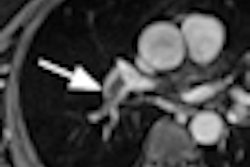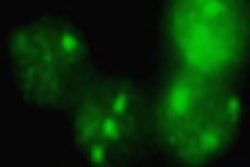Researchers from seven hospitals have concluded that MR pulmonary angiography should be considered only at centers that routinely perform the procedure well, and it should be done only for patients for whom standard tests are contraindicated.
The results, published in the April issue of Annals of Internal Medicine, also indicate that MR pulmonary angiography and MR venography combined have greater sensitivity than MR pulmonary angiography alone in patients with technically adequate images.
The lead author of the research is Dr. Paul Stein from Michigan State University in East Lansing (Ann Intern Med, April 2010, Vol. 152:7, pp. 434-443).
The study was designed to investigate the performance of MR angiography, with or without MR venography, for diagnosing pulmonary embolism, according to Stein and colleagues, who noted that previous research has not conclusively determined the accuracy of gadolinium-enhanced MR pulmonary angiography and MR venography for diagnosing pulmonary embolism.
The prospective study was conducted at seven medical centers from April 2006 to September 2008. A total of 371 adults with diagnosed or excluded pulmonary embolism were enrolled.
The researchers measured sensitivity, specificity, and likelihood ratios by comparing independently read MR images with the reference standard for diagnosing pulmonary embolism. Reference standard diagnosis or exclusion was made by using various tests, including CT angiography and venography, ventilation/perfusion lung scan, venous ultrasonography, D-dimer assay, and clinical assessment.
In their analysis, the researchers found that MR angiography across the facilities was "technically inadequate" for 25% of the patients (92 cases), ranging from 11% to 52% at the centers.
With patients with technically inadequate images included in the review, MR angiography was able to identify 57% (59 of 104 patients) with pulmonary embolism. Technically adequate MR angiography achieved sensitivity of 78% and a specificity of 99%.
By comparison, technically adequate MR angiography and venography had a sensitivity of 92% and a specificity of 96%. However, results from 194 (52%) of 370 patients were deemed to be technically inadequate.
Stein and colleagues concluded that MR pulmonary angiography and MR venography combined have a "higher sensitivity than MR pulmonary angiography alone in patients with technically adequate images, but it is more difficult to obtain technically adequate images with the two procedures."
One limitation cited by the researchers was the high proportion of patients with suspected embolism who were not eligible or declined to participate in the study.
By Wayne Forrest
AuntMinnie.com staff writer
April 13, 2010
Related Reading
CAD offers value in detecting pulmonary embolism, March 26, 2010
Survey: CT most popular choice for suspected PE, December 23, 2009
3T MRA best detects small unruptured intracranial aneurysms, November 10, 2009
CT supplants V/Q scanning for pulmonary embolism detection, October 20, 2009
MRA recommended over CTA for following Kawasaki disease, July 6, 2009
Copyright © 2010 AuntMinnie.com



















